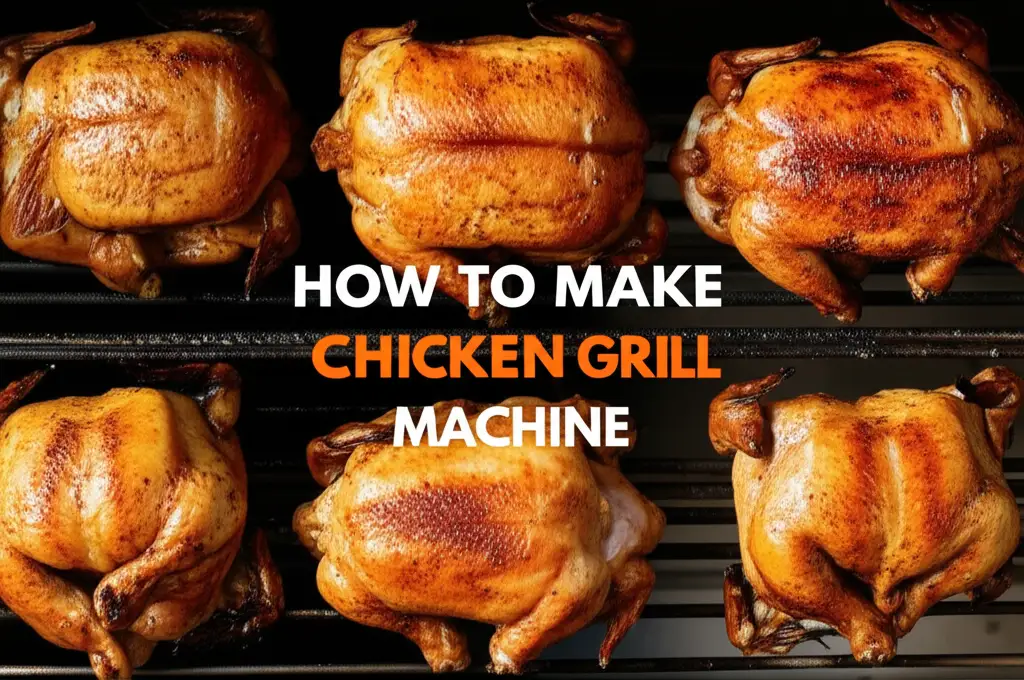· Elira Thomsen · DIY Projects · 12 min read
How To Make Chicken Grill Machine

Build Your Own Chicken Grill Machine: A DIY Guide
There is nothing quite like the smell of perfectly grilled chicken. Imagine achieving that crispy skin and juicy interior right in your backyard, using a machine you built yourself. Creating a chicken grill machine at home lets you enjoy custom features and the pride of a DIY project. It also offers a cost-effective way to achieve restaurant-quality results for your family and friends. This article will guide you through the process of how to make a chicken grill machine, from planning and material selection to assembly and safety tips.
Takeaway
- Design Your Grill: Plan the frame, heat source, and rotisserie system.
- Gather Materials: Select heat-resistant metals, a robust motor, and necessary tools.
- Construct the Frame: Build a stable base and structure for your grill.
- Install Heat Source: Choose between charcoal, gas, or electric heating elements.
- Assemble Rotisserie: Mount the motor, spit rod, and balancing components.
- Prioritize Safety: Implement proper ventilation, insulation, and electrical precautions.
- Maintain Regularly: Clean your grill components to ensure longevity and safe operation.
You can make a chicken grill machine by designing a sturdy metal frame, integrating a heat source like charcoal or electric elements, and installing a motorized rotisserie system. This project requires basic fabrication skills, essential tools, and a clear understanding of safety protocols to ensure a functional and durable grilling appliance.
Why Build Your Own Chicken Grill Machine?
You might wonder, why should I make a chicken grill machine when I can buy one? The answer is simple: customization, cost savings, and personal satisfaction. Building your own grill allows you to tailor its size and features exactly to your needs. Perhaps you want a larger capacity for family gatherings or specific types of heat control.
Making your own machine often saves a significant amount of money compared to purchasing a high-end model. You buy raw materials and components, bypassing retail markups. Furthermore, the satisfaction of cooking a delicious chicken on a grill you engineered yourself is incredibly rewarding. It turns a simple meal into a memorable achievement.
Essential Components for Your DIY Grill
When you decide to make a chicken grill machine, understanding its core parts is crucial. Every effective grill machine needs several key components to function well. These parts work together to cook chicken evenly and efficiently. Let’s break down what you will need.
The Grill Frame
The frame forms the backbone of your chicken grill machine. It provides the structure and stability for all other components. You need a frame that is sturdy and can withstand high temperatures. Steel or stainless steel tubing is usually the best choice for this purpose. The frame must support the weight of the chicken, the heat source, and the rotisserie mechanism.
Heat Source Integration
Your grill machine needs a way to cook the chicken. You have a few options for the heat source. Many people prefer charcoal for its smoky flavor. Others might choose electric heating elements for convenience and precise temperature control. Some advanced DIYers even integrate gas burners. Your choice will influence the overall design and necessary safety features of your chicken grill machine.
The Rotisserie Mechanism
A rotisserie is what makes a chicken grill machine special. It ensures the chicken cooks evenly by rotating it slowly over the heat. This mechanism includes a motor, a spit rod, and forks to hold the chicken. The motor needs to be strong enough to turn the chicken without straining. The spit rod should be heat-resistant and durable.
Drip Tray and Grease Management
Grilling chicken produces a lot of grease and drippings. A drip tray is essential for collecting these. It prevents flare-ups and makes cleaning much easier. Position the drip tray directly below the chicken but above the heat source. This component helps maintain a cleaner cooking environment.
Selecting the Right Materials and Tools
The success of your chicken grill machine project heavily relies on choosing appropriate materials and having the right tools. Using good quality materials ensures durability and safety. The proper tools make the building process smoother and more accurate. This section will guide you through your selections.
Heat-Resistant Metals
You absolutely must use metals that can withstand high temperatures. Steel is a common and affordable option, but stainless steel offers superior rust resistance and a longer lifespan. Galvanized steel is not recommended for parts that come into direct contact with food or high heat, as its coating can emit toxic fumes when heated. Think about the thickness of the metal too; thicker gauges will offer more stability and heat retention.
Choosing the Right Motor
The rotisserie motor is the heart of your chicken grill machine. It needs to be a heavy-duty, geared motor capable of slow rotation. Look for motors specifically designed for rotisserie use. Consider the weight capacity of the motor; it must be able to turn your desired amount of chicken without stalling. Many outdoor-rated motors are available, ensuring they can withstand varying weather conditions if your grill is for outdoor use.
Essential Construction Tools
Building a chicken grill machine involves some metal work. You will likely need a metal saw or grinder for cutting metal pieces. A welding machine is often necessary to join metal parts securely. If welding is not an option, you might consider bolt-together designs, but these may be less rigid. Other useful tools include a drill for making holes, measuring tapes, safety gloves, and eye protection. Safety is paramount when working with tools and metal.
Step-by-Step Guide to Constructing Your Grill
Now, let’s get into the practical steps of how to make a chicken grill machine. This process involves careful planning and execution. We will break it down into manageable stages, from the initial design to the final assembly.
Planning and Design Blueprint
Before you cut any metal, draw a detailed plan. Decide the overall dimensions of your chicken grill machine. Consider how many chickens you want to grill at once. Think about the placement of the heat source, the rotisserie motor, and the drip tray. A clear blueprint helps prevent mistakes and ensures all components fit together correctly. Measure everything twice before cutting once.
Cutting and Shaping Metal Components
With your blueprint ready, start cutting your metal. Use a metal saw or angle grinder to cut the steel or stainless steel tubing for the frame. Cut the sheet metal for the body and drip tray. Accuracy is important here for a square and stable frame. Take your time with each cut.
Welding or Bolting the Frame
Next, assemble the frame. If you are welding, ensure strong, continuous welds at all joints for maximum stability. Practice welding on scrap pieces first if you are new to it. If you are bolting, drill precise holes and use heavy-duty bolts, nuts, and washers. A bolted frame can be disassembled for transport or storage, which is a useful feature for some users.
Installing the Heat Source and Rotisserie
Mount your chosen heat source within the frame. Ensure proper ventilation if you use charcoal or gas. For electric elements, secure them safely and ensure no bare wires are exposed. Then, install the rotisserie motor on one side of the frame. Mount the spit rod supports on opposing sides, ensuring the spit rod can rotate freely. Test the motor with the spit rod to confirm smooth operation.
Adding Features and Finishing Touches
Finally, add the practical features. Secure the drip tray below the spit rod. You might add wheels for portability. Consider attaching side shelves for holding tools or plates. Apply high-heat paint to any exposed metal parts (not food-contact surfaces) for aesthetics and rust prevention. These finishing touches complete your chicken grill machine.
Safety First: Operating and Maintaining Your Homemade Grill
Building your own chicken grill machine is a rewarding project, but safety must always be your top priority. Improper operation or maintenance can lead to serious hazards. This section will cover crucial safety measures and maintenance tips to ensure your homemade grill machine serves you well and safely for years to come.
Proper Ventilation and Heat Management
Grilling generates intense heat and smoke. Always operate your chicken grill machine outdoors or in a very well-ventilated area. Never use a charcoal or gas grill indoors; carbon monoxide poisoning is a silent danger. Ensure your grill’s design allows for adequate airflow around the heat source to prevent overheating. Consider adding insulation to the outer shell of the grill to prevent burns from accidental contact.
Electrical Safety for Rotisserie Motors
If your chicken grill machine uses an electric rotisserie motor, electrical safety is paramount. Ensure all wiring is properly insulated and protected from moisture. Use outdoor-rated extension cords if needed, and never overload circuits. Install a ground fault circuit interrupter (GFCI) outlet if possible. This offers an extra layer of protection against electrical shocks. Regularly inspect wires for fraying or damage before each use.
Regular Cleaning and Inspection
Proper maintenance extends the life of your chicken grill machine and keeps it safe. After each use, allow the grill to cool completely, then remove all food debris and grease. The drip tray should be emptied and cleaned to prevent grease fires. You can learn more about general grill cleaning techniques to keep your machine in top shape, like how to clean a panini grill or tackle specific issues like how to clean flat top grill rust. Regularly inspect your grill for signs of wear, loose bolts, or rust. Pay special attention to components like the motor, spit rod, and heat source for any damage. Addressing issues promptly prevents larger problems down the line. If your grill uses gas, you might want to understand how to clean gas grill venturi tubes for optimal gas flow and performance.
Customization and Enhancements for Your Grill
Once you have built your basic chicken grill machine, you can start thinking about ways to enhance it. Customization is one of the best advantages of a DIY project. You can add features that make your grilling experience even better. These enhancements can improve convenience, performance, and versatility.
Temperature Gauges and Controls
Adding a temperature gauge to your grill lid or body allows for precise heat monitoring. This helps you maintain consistent cooking temperatures. For electric or gas heat sources, consider integrating a thermostat or control knob. This gives you more control over the flame or heating element, ensuring perfectly cooked chicken every time. Accurate temperature control is key for consistent results.
Side Tables and Storage
Practical side tables make grilling much easier. You can attach folding or fixed tables to the side of your grill frame. These provide space for platters, tools, spices, and sauces. Below the grill, you might add a small storage shelf for charcoal bags or propane tanks. This keeps your grilling area organized and efficient.
Integrated Lighting and Rotisserie Speeds
For evening grilling, integrated LED lights can illuminate your cooking surface. This is a simple but very useful addition. You could also explore a multi-speed rotisserie motor. Different speeds can be beneficial for various stages of cooking or for different types of meat. Some grillers prefer a slower rotation for a deeper sear, while others like a faster speed for even cooking.
FAQ Section
What materials are best for a homemade chicken grill machine?
The best materials for a homemade chicken grill machine are steel or stainless steel for the frame and components that contact heat. Stainless steel offers excellent corrosion resistance and durability. Avoid galvanized steel in high-heat areas. Ensure all materials are food-grade and heat-resistant for safe operation.
How much does it cost to make a chicken grill machine?
The cost to make a chicken grill machine varies widely based on design complexity and material choices. A simple build might cost a few hundred dollars for metal, a motor, and basic hardware. More elaborate designs with advanced features and premium materials could push the cost higher. It is often still less expensive than a commercial unit.
What type of motor do I need for a rotisserie grill?
You need a heavy-duty, geared rotisserie motor. Look for motors specifically designed for outdoor grilling and capable of slow rotation. The motor’s weight capacity is important; it must be able to turn the maximum weight of chicken you plan to grill. Ensure the motor is protected from the elements if used outdoors.
Can I use my homemade grill indoors?
No, you should never use a charcoal or gas-powered homemade grill machine indoors. These produce carbon monoxide, a dangerous, odorless gas. Electric grills can be used indoors with proper ventilation, but it is always safest to operate any grill outdoors. Ensure your space has good airflow.
How do I clean and maintain my DIY chicken grill?
Clean your DIY chicken grill after each use by removing food debris and emptying the drip tray. Use a grill brush for grates and a degreaser for surfaces. Regularly inspect for rust, loose bolts, or wiring damage. Keeping it clean and checking components ensures longevity and safe operation.
Conclusion
Creating your own chicken grill machine is a rewarding endeavor that brings delicious results. We have explored how to make a chicken grill machine, covering everything from initial design to final touches. This DIY project offers the satisfaction of custom equipment and significant cost savings. You have learned about essential components, material selection, and critical safety considerations.
Building a grill machine provides unique insights into how cooking appliances work. Remember to prioritize safety during construction and operation. Always ensure proper ventilation and regular maintenance for your homemade grill. Get ready to impress your friends and family with perfectly grilled chicken, cooked on a machine you built with your own hands. Start planning your project today and enjoy the taste of true DIY success!
- homemade chicken grill
- DIY grill machine
- rotisserie build
- grilling projects
- outdoor kitchen
- chicken cooker
- metal fabrication





